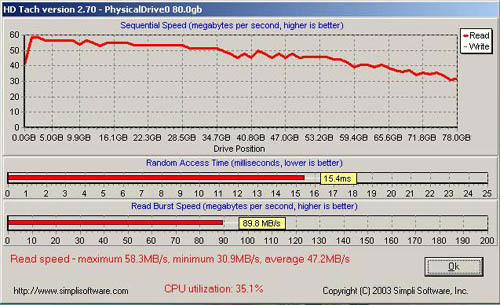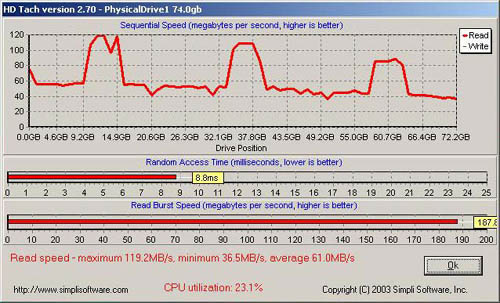nForce3-250 - Part 2: Taking Athlon 64 to the Next Level
by Wesley Fink on March 29, 2004 11:00 AM EST- Posted in
- CPUs
nForce3-250Gb: IDE and RAID Benchmarks
Disk Performance Testing can provide extremely variable results, even when test conditions are well-controlled. For that reason, we were skeptical to drop IDE and RAID tests into our review of the nForce3-250Gb. However, it was certain, given nVidia's past lackluster drive performance, that HD tests should be included in nF3-250 benchmarking.Some of the most commonly used benchmarks for Hard Drive Testing are HDtach 2.7, PCMark 2004 HD Tests and SiSoft Sandra 2004 File System Benchmark. We have included all 3 test results here for both IDE and nVidia RAID. Tests in both cases were run on Hard Drives about 20% full, with the benchmark run from the IDE hard drive. The IDE hard drive was a 7200 RPM 80GB drive with a 50GB C: boot partition, and tests were run on C:. The RAID array was 2 Western Digital Raptor 10,000 RPM 36.7GB hard drives. Both the IDE and RAID were driven by nVidia IDE drivers in nForce Platform Driver 4.04.
Sandra 2004 shows a 38% increase in throughput with nVidia 10,000RPM RAID compared to a single 10,000RPM SATA drive. PCMark 2004 HDD Test Suite shows a smaller increase in performance with RAID, around 27%. Benchmarks for a single 7200RPM IDE are also included for comparison.
Perhaps even more important for critics of past nVidia IDE implementations is that nVidia and Intel throughput in IDE is now about the same with the nForce3-250Gb. Intel SATA RAID is a bit faster in Sandra, but the difference in measured benchmark performance was very small, at about 6%.
For those who hate the numbers from benchmarks like Sandra and PCMark, the HDTach screen captures provide a very interesting snapshot. The two graphs below, with blue title bars, represent nVidia's nForce3-250Gb drive controller performance.


We also tested the Intel RAID controller with another pair of 10,000 rpm Western Digital Raptors. Those results are shown with the green title bar below.

As you can see, performance of the Intel SATA RAID and nVidia SATA RAID are virtually identical.
The biggest surprise in the HD Tach benchmarks was the fact that SATA RAID requires half the overhead of basic IDE in nVidia's implementation. However, the CPU utilization, while greatly improved over numbers we have seen for nVidia in the past, is still very high compared to Intel's SATA RAID. Part of this has to do with the architectural differences between Athlon 64 and Intel processors and chipsets, but there is still a large difference in CPU overhead between the nVidia and Intel RAID solutions. Frankly, the real performance difference is likely to be nil on the typical desktop, but this will matter to some.










46 Comments
View All Comments
Brickster - Monday, March 29, 2004 - link
Can one expect the following from nf3-250?-939 Mobo
-DualChannel
-PCI-X
Any other chipsets for this?
amalinov - Monday, March 29, 2004 - link
"Certainly, we will see 4 DIMMs, or two matched pairs, on the dual-channel nForce3-250Gb Ultra version of this chipset."again totaly unconnected with reality.
in A64/Opteron the chipset has nothing to do with memory support. How much DIMMs are supported depends on CPU, mainboard and BIOS ONLY!
There will be NO DUAL CHANNEL nf3-250Gb-Ultra. Just like nf3-250Gb IS NOT SINGLE CHANNEL.
There will be DUAL CHANNEL S939 Athlon64 CPU.
Also, another topic not well understood at Anandtech, Tom's, etc.: A64/Opteron FSB speed, HyperTransport speed, etc. - they (the writers) are mixing up clock frequency in MHz, data frequency in DDR and MHz, bandwith in GB/s. They think FSB and HyperTransport is the same thing. They think that HyperTransport is 800MHz (or maybe 200MHz "quadrupelt") - maybe becouse of similarity with P4. They think that their nf3-250Gb has a "250MHz FSB". They don't explain to the users on what depends the memory clock in a A64 system. They think that "Dual CPU support" is a feature of the chipset.
Shame on you!
Diogenes2 - Monday, March 29, 2004 - link
I remain puzzled about the continuing declaration by Anandtech about the lack of AGP locks on NF3-150 boards..I have no way to confirm it ( with O-Scope, etc. )at this time, but I am running 265 FSB on my Gigabyte GA-K8NPRO, and having no problems with my Saphire 9800 Pro.. This was not the case with the KT800 board I experimented with for a while, which would not tolerate an FSB above 225, as far as AGP was concerned..
I recommend that when the NF3-250 boards hit the shelves, buyers take advantage of price drops on NF3-150 offerings.. I don't see the modest performance gains of the NF3-250 as anything to get excited about..
amalinov - Monday, March 29, 2004 - link
just 2 lines below, another error:"nVidia includes the hooks for AC '97 6.1 audio in nForce3-250"
6.1? Don't you mean 5+1 ("6-channel 5.1")????
OK. This can be a typo-mistake, but when you add all typos, totaly wrong infos, etc. - it is too much to bear!
amalinov - Monday, March 29, 2004 - link
"Even with the memory controller on the chip, there is only so much real estate practically available on a single-chip chipset. "What???? This is not true! Where did you get such information?
SiS745, anyone? Single Chip: AGP+DDR memroy+PCI+UATA+AC97+...
also, current 0.13um, 0.15um is more advanced than SiS745.
Other single chip: ALi M1689, SiS630, SiS540
There IS enough real estate for a SoundStorm APU.
The problem can be pin-count, but is not.
Give us the area in mm2 and production technology in um of nforce3, nforce2 IGP, nforce2 MCP-T.... then can we speak.
Also give for comparation other chipsets - north&south&singlechip, other CPUs, other GPUs... give numbers for total transistors, total pins...
Generaly I think that the quality of articles in Anandtech and Tom's Hardware has declined VERY MUCH and is below acceptable now. Once these two were my favorite sites. Now I visit them only becouse they are big and so get the newest stuff and make MANY benchmarks. But if you need information about internals of a component and not its speed - they will most likely give you WRONG information. There are many other mistakes in mainboard and chipsets and other articles that start to annoy me...
tagej - Monday, March 29, 2004 - link
I do not find it surprising at all that most customers don't care about the sound storm stuff. After all, the vast majority of PC users (outside of the geek market of course) have their PC hooked up to $9.99 basic speakers -- sound storm is not going to make a difference at all, and is simply not a selling point.The 250Gb certainly looks sweet at this point... I'll be watching closely to see how the first retail boards do.
aak97 - Monday, March 29, 2004 - link
Just wanna know, did the nForce3-250Gb ref board comes with any WinXP 64bits drivers? I'm sure a lot of people (including myself) will be interested in some benchmarks on the Preview version of WinXP 64bits.Foxbat121 - Monday, March 29, 2004 - link
#4,The "customer" in the survey probably refers to nVidia's largest OEM like HP, eMachine etc. These companies only care about save a few $$ and probably only chose nForce2 without SoundStorm.
#7,
The whole point of SoundStorm is to use Dolby Digital encoding and output everything throught digital sound output where analog codec chip does not get in to the play. If you use analog ouput, you will be better of with a sound card.
KHysiek - Monday, March 29, 2004 - link
Now with Intel adding Azalia high lever audio to it's boards NVidia looks clearly dumb with it's chipset w/o Soundstorm.clemedia - Monday, March 29, 2004 - link
"On the other hand, Soundstorm offers high quality 3d audio rendering, but it is _ALWAYS_ paired with that SAME crappy Realtek ALC650 chip, which offers lousy analog output quality"Apparently you COMPLETLY overlooked the fact that most (all, AFAIK) SoundStorm boards offered digital output which bypassed those codec's completly. Which just happens to be EXACTLY what I use, and was a major selling point, allowing me to send out my DD/DTS signal to my amp for DVD's as I use for regular computer use. VERY handy.
I would have no problem switching to something else if they offed a good DICE solution. (I think C-media makes a software DICE chip, but I would rather go with something better)